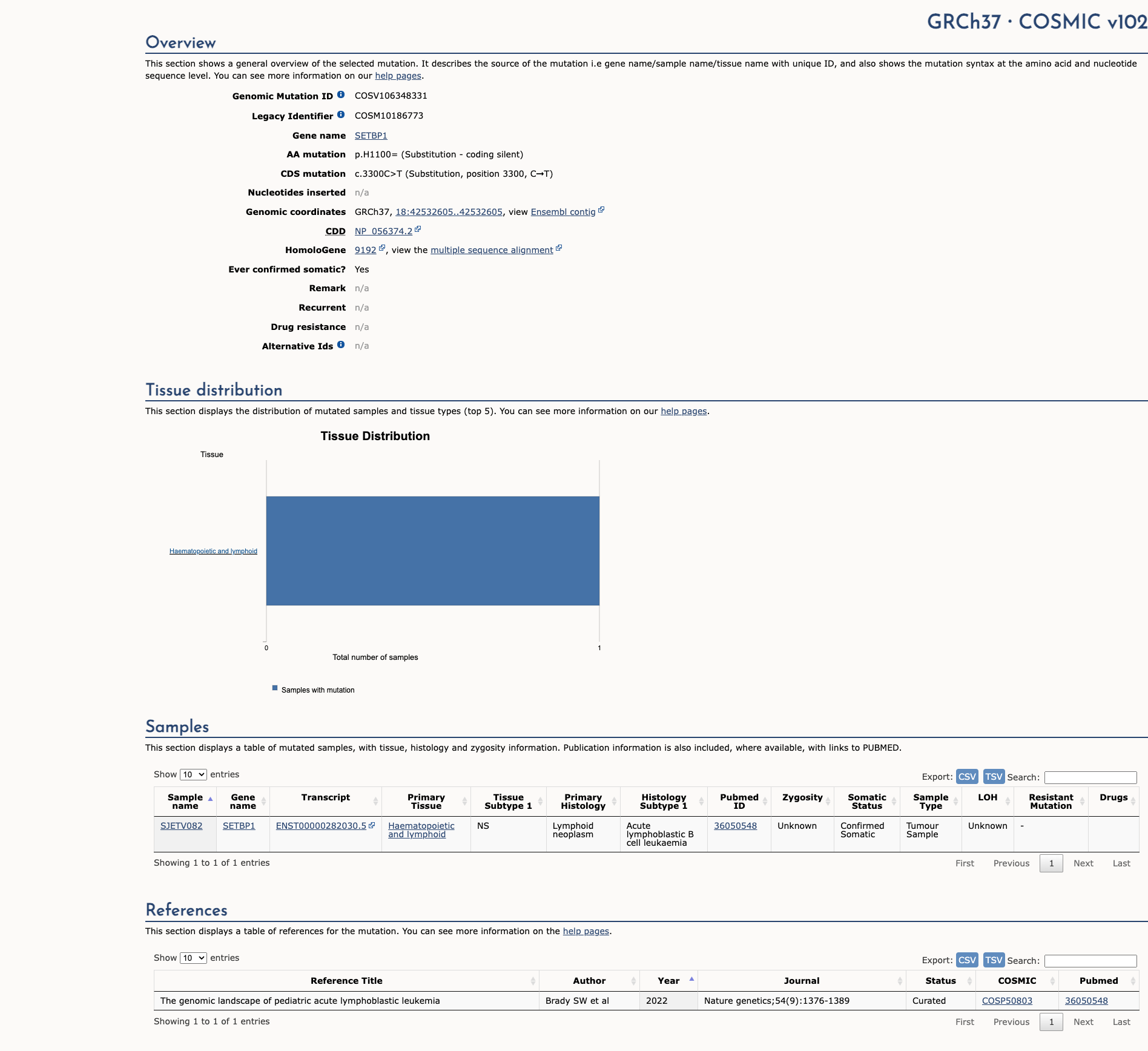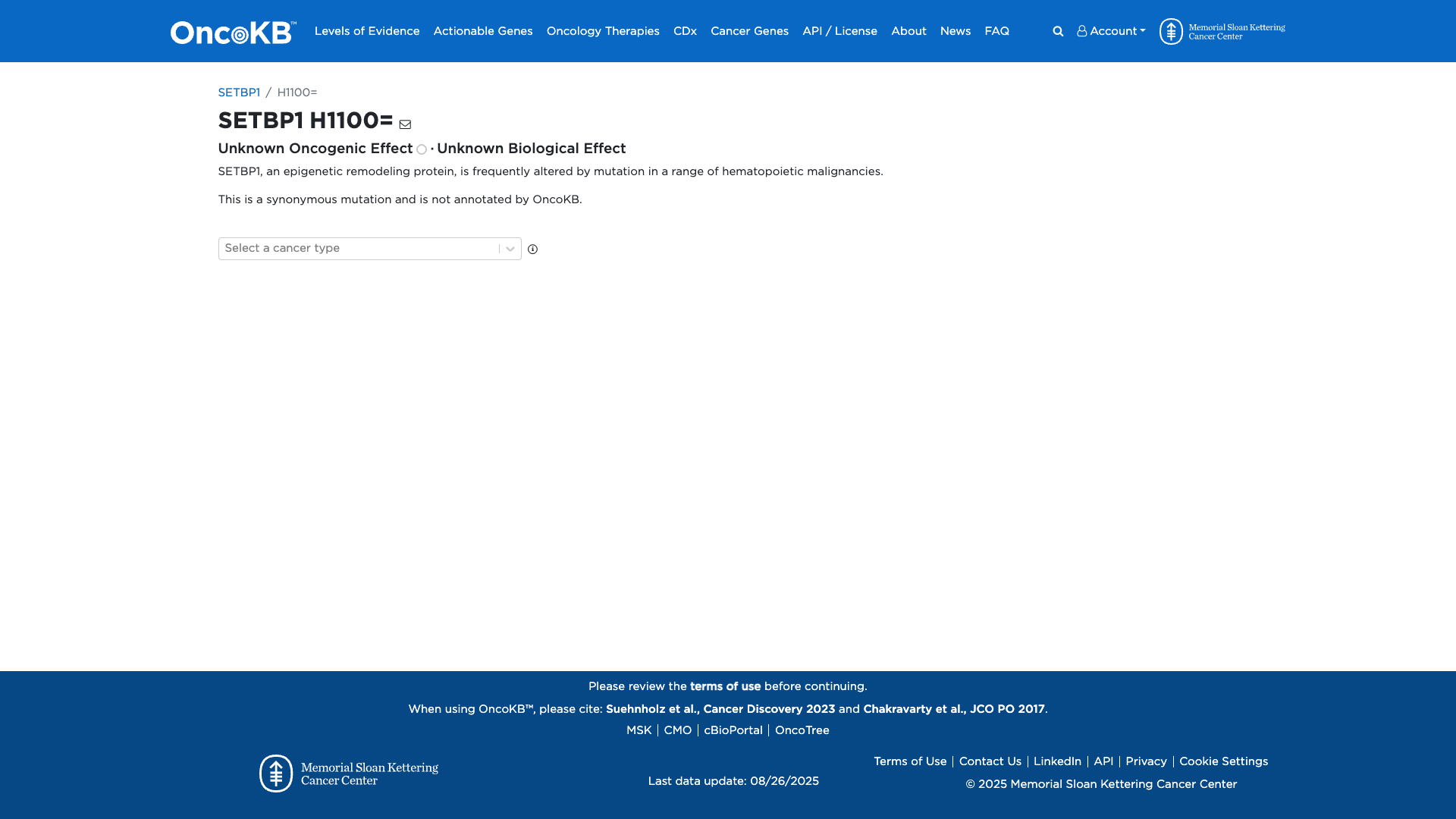SETBP1 c.3300C>T, p.His1100=
NM_015559.2:c.3300C>T
COSMIC ID: COSM10186773
Likely Benign
This synonymous SETBP1 variant is extremely rare in population databases, computational and splice predictions show no impact, and reputable sources classify it benign. No evidence for pathogenicity was found, resulting in a Likely Benign classification.
ACMG/AMP Criteria Applied
PM2
BP4
BP6
BP7
Genetic Information
Gene & Transcript Details
Gene
SETBP1
Transcript
NM_015559.3
MANE Select
Total Exons
6
Strand
Forward (+)
Reference Sequence
NC_000018.9
Alternative Transcripts
| ID | Status | Details |
|---|---|---|
| NM_015559.1 | Alternative | 5 exons | Forward |
| NM_015559.2 | Alternative | 6 exons | Forward |
Variant Details
HGVS Notation
NM_015559.2:c.3300C>T
Protein Change
H1100=
Location
Exon 4
(Exon 4 of 6)
5'Exon Structure (6 total)3'
Functional Consequence
Loss of Function
Related Variants
Alternate Identifiers
COSM10186773
Variant interpretation based on transcript NM_015559.3
Genome Browser
Loading genome browser...
HGVS InputNM_015559:c.3300C>T
Active Tracks
ConservationRefSeqClinVargnomAD
Navigation tips: Use mouse to drag and zoom. Click on features for details.
Clinical Data
Global Frequency
0.00248%
Rare
Highest in Population
African/African American
0.024%
Low Frequency
Global: 0.00248%
African/African American: 0.024%
0%
0.05%
0.1%
1%
5%
10%+
Allele Information
Total: 282076Alt: 7Homozygotes: 0
ACMG Criteria Applied
PM2
This variant is present in gnomAD (MAF= 0.00248%, 7/282076 alleles, homozygotes = 0) and at a higher frequency in the African/African American population (MAF= 0.024%, 6/24964 alleles, homozygotes = 0). The variant is rare (MAF < 0.1%), supporting PM2 criterion application.
Classification
Likely Benign
Based on 2 submitter reviews in ClinVar
Submitter Breakdown
1 LB
1 B
Pathogenic
Likely Path.
VUS
Likely Benign
Benign
Publications (0)
No publication details.
Clinical Statement
This variant has been reported in ClinVar as Benign (1 clinical laboratories) and as Likely benign (1 clinical laboratories).
Functional Impact
Functional Domain
Hotspot Status
Not a hotspot
Domain Summary
This variant is not located in a mutational hotspot or critical domain (0 mutations).
Related Variants in This Domain
Computational Analysis
Pathogenicity Predictions
Predictor Consensus
Mixed/VUS
PP3 Applied
No
Additional Predictors
Benign:
CADD: -0.13
VCEP Guidelines
Applied ACMG/AMP Criteria (VCEP Specific)
PVS1
PVS1 (Not Applied) Strength Modified
According to standard ACMG guidelines, the rule for PVS1 is: "Null variant (nonsense, frameshift, canonical ±1 or 2 splice sites, initiation codon, single exon deletion in a gene where loss of function is a known mechanism of disease)". The evidence for this variant shows: it is a synonymous (silent) change with no predicted effect on protein. Therefore, this criterion is not applied because the variant does not produce a null allele.
PS1
PS1 (Not Applied) Strength Modified
According to standard ACMG guidelines, the rule for PS1 is: "Same amino acid change as a known pathogenic variant but different nucleotide change". The evidence for this variant shows: there is no amino acid change (synonymous). Therefore, this criterion is not applied because the variant does not alter the protein sequence.
PS2
PS2 (Not Applied) Strength Modified
According to standard ACMG guidelines, the rule for PS2 is: "De novo (both maternity and paternity confirmed) in a patient with the disease and no family history". The evidence for this variant shows: no de novo status or family data available. Therefore, this criterion is not applied due to lack of de novo confirmation.
PS3
PS3 (Not Applied) Strength Modified
According to standard ACMG guidelines, the rule for PS3 is: "Well-established functional studies supportive of a damaging effect on the gene or gene product". The evidence for this variant shows: no functional studies have been performed. Therefore, this criterion is not applied due to absence of functional data.
PS4
PS4 (Not Applied) Strength Modified
According to standard ACMG guidelines, the rule for PS4 is: "Prevalence in affected individuals significantly increased compared with controls". The evidence for this variant shows: no case-control or affected individual frequency data. Therefore, this criterion is not applied due to lack of evidence of enrichment in cases.
PM1
PM1 (Not Applied) Strength Modified
According to standard ACMG guidelines, the rule for PM1 is: "Located in a mutational hot spot or well-established functional domain without benign variation". The evidence for this variant shows: not located in any known hotspot or critical domain. Therefore, this criterion is not applied.
PM2
PM2 (Moderate)
According to standard ACMG guidelines, the rule for PM2 is: "Absent from controls (or at extremely low frequency if recessive) (Table 6) in Exome Sequencing Project, 1000 Genomes Project, or Exome Aggregation Consortium". The evidence for this variant shows: MAF = 0.00248% in gnomAD (7/282076 alleles, no homozygotes) and extremely rare across populations. Therefore, this criterion is applied at Moderate strength because the variant is at an extremely low frequency in controls.
PM3
PM3 (Not Applied) Strength Modified
According to standard ACMG guidelines, the rule for PM3 is: "Detected in trans with a pathogenic variant (for recessive disorders)". The evidence for this variant shows: zygosity and phase information with a pathogenic allele are not available. Therefore, this criterion is not applied.
PM4
PM4 (Not Applied) Strength Modified
According to standard ACMG guidelines, the rule for PM4 is: "Protein length changes due to in-frame deletions/insertions or stop-loss variants". The evidence for this variant shows: it is a single-nucleotide synonymous change with no effect on protein length. Therefore, this criterion is not applied.
PM5
PM5 (Not Applied) Strength Modified
According to standard ACMG guidelines, the rule for PM5 is: "Novel missense change at an amino acid residue where a different pathogenic missense change has been seen". The evidence for this variant shows: it is synonymous, not missense. Therefore, this criterion is not applied.
PM6
PM6 (Not Applied) Strength Modified
According to standard ACMG guidelines, the rule for PM6 is: "Assumed de novo, but without confirmation of paternity and maternity". The evidence for this variant shows: no information on de novo status. Therefore, this criterion is not applied.
PP1
PP1 (Not Applied) Strength Modified
According to standard ACMG guidelines, the rule for PP1 is: "Co-segregation with disease in multiple affected family members". The evidence for this variant shows: no family segregation data. Therefore, this criterion is not applied.
PP2
PP2 (Not Applied) Strength Modified
According to standard ACMG guidelines, the rule for PP2 is: "Missense variant in a gene with a low rate of benign missense variation and where missense variants are a common mechanism of disease". The evidence for this variant shows: it is synonymous, not missense. Therefore, this criterion is not applied.
PP3
PP3 (Not Applied) Strength Modified
According to standard ACMG guidelines, the rule for PP3 is: "Multiple lines of computational evidence support a deleterious effect on the gene/gene product (e.g., conservation, splicing impact)". The evidence for this variant shows: in silico predictors (CADD = –0.13, SpliceAI max = 0.01) indicate no deleterious effect. Therefore, this criterion is not applied.
PP4
PP4 (Not Applied) Strength Modified
According to standard ACMG guidelines, the rule for PP4 is: "Patient's phenotype or family history highly specific for a disease with a single genetic etiology". The evidence for this variant shows: no phenotype or clinical data provided. Therefore, this criterion is not applied.
PP5
PP5 (Not Applied) Strength Modified
According to standard ACMG guidelines, the rule for PP5 is: "Reputable source reports variant as pathogenic, but without accessible evidence". The evidence for this variant shows: reputable sources report it as benign/likely benign only. Therefore, this criterion is not applied.
BA1
BA1 (Not Applied) Strength Modified
According to standard ACMG guidelines, the rule for BA1 is: "Allele frequency is too high for the disorder (based on population data)". The evidence for this variant shows: MAF = 0.00248% which is well below any BA1 threshold. Therefore, this criterion is not applied.
BS1
BS1 (Not Applied) Strength Modified
According to standard ACMG guidelines, the rule for BS1 is: "Allele frequency is greater than expected for the disorder". The evidence for this variant shows: MAF = 0.00248%, not greater than expected thresholds. Therefore, this criterion is not applied.
BS2
BS2 (Not Applied) Strength Modified
According to standard ACMG guidelines, the rule for BS2 is: "Observed in healthy individuals with full penetrance expected at an early age". The evidence for this variant shows: observed in gnomAD but penetrance data are unknown. Therefore, this criterion is not applied.
BS3
BS3 (Not Applied) Strength Modified
According to standard ACMG guidelines, the rule for BS3 is: "Well-established functional studies show no damaging effect on protein function or splicing". The evidence for this variant shows: no functional studies available. Therefore, this criterion is not applied.
BS4
BS4 (Not Applied) Strength Modified
According to standard ACMG guidelines, the rule for BS4 is: "Lack of segregation in affected family members". The evidence for this variant shows: no family segregation information. Therefore, this criterion is not applied.
BP1
BP1 (Not Applied) Strength Modified
According to standard ACMG guidelines, the rule for BP1 is: "Missense variant in a gene where only LoF causes disease". The evidence for this variant shows: it is synonymous, not missense. Therefore, this criterion is not applied.
BP2
BP2 (Not Applied) Strength Modified
According to standard ACMG guidelines, the rule for BP2 is: "Observed in trans with a pathogenic variant for dominant disorders or in cis with a pathogenic variant". The evidence for this variant shows: no information on phase with other variants. Therefore, this criterion is not applied.
BP3
BP3 (Not Applied) Strength Modified
According to standard ACMG guidelines, the rule for BP3 is: "In-frame deletions/insertions in a repetitive region without known function". The evidence for this variant shows: it is a single nucleotide substitution, not an indel. Therefore, this criterion is not applied.
BP4
BP4 (Supporting)
According to standard ACMG guidelines, the rule for BP4 is: "Multiple lines of computational evidence suggest no impact on gene or gene product (e.g., conservation, evolutionary, splicing impact)". The evidence for this variant shows: in silico predictors (CADD = –0.13) and SpliceAI (max = 0.01) predict no impact. Therefore, this criterion is applied at Supporting strength.
BP5
BP5 (Not Applied) Strength Modified
According to standard ACMG guidelines, the rule for BP5 is: "Variant found in a case with an alternate molecular basis for disease". The evidence for this variant shows: no case reports with alternate molecular diagnoses. Therefore, this criterion is not applied.
BP6
BP6 (Supporting)
According to standard ACMG guidelines, the rule for BP6 is: "Reputable source reports variant as benign, but without accessible evidence". The evidence for this variant shows: reported in ClinVar as Benign (1 lab) and Likely Benign (1 lab). Therefore, this criterion is applied at Supporting strength.
BP7
BP7 (Supporting)
According to standard ACMG guidelines, the rule for BP7 is: "Synonymous variant with no predicted impact on splicing". The evidence for this variant shows: it is synonymous and SpliceAI predicts no splice impact (max = 0.01). Therefore, this criterion is applied at Supporting strength.



